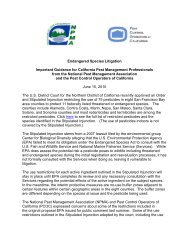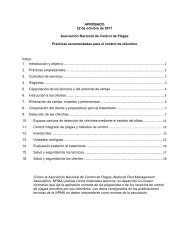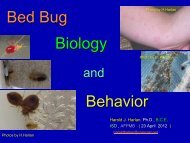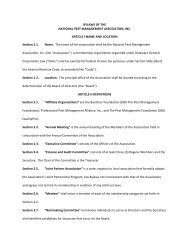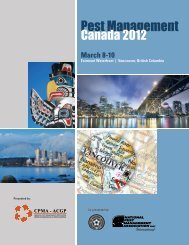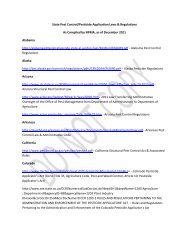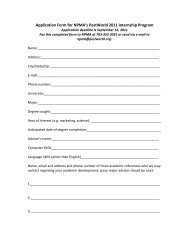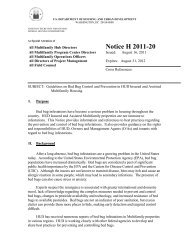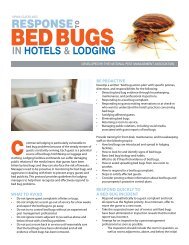Pest Management Standards For Food Plants - National Pest ...
Pest Management Standards For Food Plants - National Pest ...
Pest Management Standards For Food Plants - National Pest ...
You also want an ePaper? Increase the reach of your titles
YUMPU automatically turns print PDFs into web optimized ePapers that Google loves.
SECTION 2: PEST MANAGEMENT PLAN<br />
Proper care must be exercised to comply with the label in terms of access to children or<br />
non-target animals. If it is not possible to install stations in secure areas then glue boards<br />
or snap traps or other mechanical traps may be used inside of locked and anchored<br />
stations.<br />
Monitoring stations may be used at any interval with a non-toxic block.<br />
EXTERIOR PERIMETER<br />
Property Perimeter: If an exterior property perimeter program is utilized, then based<br />
upon history only, rodent management equipment, such as but not limited to rodent bait<br />
stations or multiple-catch traps, shall be placed along property perimeter areas (e.g. fence<br />
lines or outer boundaries) at the rate of:<br />
• <strong>For</strong> History Category 1: Spacing of not more than 50 feet<br />
• <strong>For</strong> History Category 2: Spacing of 50-75 feet<br />
• <strong>For</strong> History Category 3: Spacing of up to 100 feet<br />
2<br />
SECTION<br />
Exterior Building Areas (buildings at or near exterior walls of buildings on plant property)<br />
Based upon history, rodent bait stations shall be placed along building exterior areas at<br />
the rate of:<br />
• <strong>For</strong> History Category 1: Spacing of not more than 25 feet<br />
• <strong>For</strong> History Category 2: Spacing of between 25-50 feet<br />
• <strong>For</strong> History Category 3: Spacing of up to 75 feet<br />
Rodent management devices should be added adjacent to doors, docks, and ramps to the<br />
level of History Category 1 at least but may be placed adjacent to any exterior opening<br />
per company practices.<br />
INTERIOR OF PLANT<br />
The inside of any exterior wall should have multiple-catch traps or glueboards in stations<br />
at the rate of one per 20-40 feet. In areas of high traffic, stations should be placed directly<br />
against the wall and should be protected or covered if necessary to prevent forklift<br />
damage. Interior traps do not have to be anchored. Traps may be placed along interior<br />
walls at the discretion of the pest management company. Interior rodent management<br />
programs shall be monitored weekly.<br />
Multiple-catch traps may be supplemented at a rate determined by the technician with<br />
snap traps in stations or glue boards added into PVC pipes. These traps may be used also<br />
on mezzanines where equipment is stored and in areas where using large traps may be<br />
cumbersome, such as in areas of heavy activity and dense storage areas. All stations must<br />
be recorded and numbered and records must reflect the placement.<br />
Rodenticides shall not be used inside food plants in any area unless approved by the plant<br />
contact and permitted by label. Upon such a request, any action and reasoning must be<br />
documented and should be temporarily used when there is no exposed food product.<br />
Non-toxic monitoring blocks may be used if permitted by plant contact.<br />
<strong>Plants</strong> should have an inspection aisle of at least 18 inches along walls. Commonly, this<br />
area is painted white in order to contrast with droppings or insects. Traps may be placed<br />
along these areas.<br />
Due to concerns about allergens, no peanut butter or nut based attractants may be used<br />
inside a plant unless approved by plant contact.<br />
11



